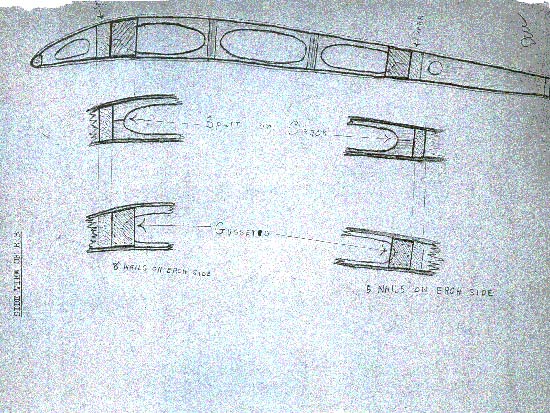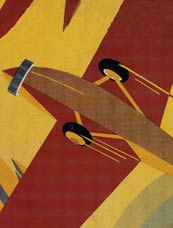|
UNUSUALLY ACCIDENT-PRONE
This airplane is identified in the Register as a “Cub”. It was clearly too early to be a Piper aircraft. I asked Bill Piper, Jr. about it and he guessed that it could be, “One of the early [Taylor] E-2 Cubs.” Bill visited Tucson in December 1934 flying NC14707, a Taylor E-2.
A little research shows it wasn’t a Taylor aircraft at all. It was manufactured June 1, 1930 by the California Aircraft Corp., Los Angeles, CA as S/N 2 under ATC# 2-271. It left the factory as a model D-1 with a Lambert R-266 engine of 90HP. It was a two-place high wing parasol monoplane. Later, in 1937, it became a model D-1-K when it had a Kinner K-5 engine of 100HP installed. Below is a photograph of 137W from Juptner, Volume 9, page 147, dated sometime during 1930.
NC137W, Ca. September 1930 (Source: Juptner)
 |
Our “California Cub” landed at Tucson September 18, 1930 at 4:30PM. It was flown by Joe Woolfolk carrying one unidentified passenger. Based in Los Angeles, CA they were westbound from Hobbs, NM to Los Angeles. Another image of this airplane is here on aerofiles.com. Mr. Woolfolk's name shows up in none of the paperwork analysis that follows.
According to the NASM record, NC137W had installed a Standard steel propeller, S/N 11989. It suffered an accident when it was about six-months old on December 30, 1930 at Los Angeles, CA and its registration was suspended by the Civil Aeronautics Authority on January 16, 1931. Its registration was reinstated five days later. There was some litigation surrounding this accident that involved the propeller, but the FAA record does not go into detail except to note that the Department of Commerce made a request to examine the propeller after the litigation was ended.
Another accident on February 3, 1931 resulted in a suspension-reinstatement on February 26 and March 5, respectively.There was yet another accident-suspension-reinstatement cycle on April 1, 1931, April 13 and May 23, respectively. There is a gap in information until March 14, 1934 when NC137W was sold to Robert C. Hammond of Alhambra Airport, Alhambra, CA. A year later at inspection the total flight time on March 13, 1935 was 525 hours.
On December 27, 1935 the airplane was sold to Carlyle C. Madson of National City, CA. Madson owned and operated the Madson Flying Service. His company letterhead located him on Tijuana Highway, US 101, 3 miles from the San Diego city limits. His business was "student instruction" and "passenger flights".
NC137W had a Fahlin wooden propeller, S/N 1605 installed by March 10, 1936. It had accumulated 846 flight hours by this date. Note that over 300 hours had been accumulated in the past year: a relatively high rate of use indicative of a busy student trainer.
This airplane underwent some interesting modifications while owned by Madson, some of which did not seem to align with student training and passenger flights. It was converted for installation of a Kinner K-5 engine on about November 12, 1937. The engine change included a a modification of the engine mount , oil tank, and installation of a Fahlin D-620 propeller. This installation left a propeller ground clearance of only 7 7/8" -- not much room for landing or taxi error.
It was re-registered as NX137W on November 19, 1937 and assigned a new model designation: "Cub D-1-K". Its license through 1938 specified that no passengers, other than required crew, were to be carried. Two parachutes, at a cumulative weight of 40-pounds, were to be carried. The image of this airplane linked above does not appear to have this large propeller installed.
It was re-registered "NC" during May 1938 with a Story D-838 wooden propeller. This propeller complied with the maximum 87" radius allowed in the type certificate. This reassignment was performed by owner Madson, and some correspondence identifies the airplane as type "Madson California Cub Model D-1-K". Contingent to the reassignment, the engine was placarded and stopped to a 1,650 RPM limit, with a solo pilot occupying the back seat only. The airplane cruised at 84 MPH.
Times must have been hard in these latter days of the Great Depression, because on January 15, 1940 Mr. Madson filed with the Civil Aeronautics Authority a $500 lien against NC137W and a Stinson he owned, payable to one Robert Boggeman of San Diego, CA.
Yet again another accident occurred on April 12, 1940 at 3PM at National City, CA while the airplane was being operated by Robert Boggeman. According to the official report, "This accident was the result of too fast taxiing without brakes. The plane turned cross wind and ran into a car parked near the hangar; when the pilot attempted to taxi back to the end of the field for take-off while practicing landings."
There were no injuries during this accident, but the wings suffered cracked ribs. There were 13 ribs in each wing panel. The right wing suffered cracks in the forward rib webs of ribs 4, 11 and 12 and in the rear webs of ribs 11 and 12. The left wing suffered cracks in the forward webs of ribs 6, 7, 8 and 11. These cracks were mitigated by fitting three-ply, 1/8" mahogany plywood gussets over the cracks and attaching them with nails and casein glue. Diagrams for this repair are included in the FAA documentation. Repairs of wooden airplanes are performed very much the same way today, except resorcinol or epoxy glues are used in place of casein.
Rib Repair Diagrams, 1940
 |
Interestingly, the diagram specifies five nails for the aft gussett, but seven are illustrated. The varnish-coated brass nails used today are still the same as specified for this repair in 1940.
The airplane had a California Fritzen fixed-pitch wooden propeller, model KB5-10, S/N 2812 installed by August 7, 1940. According to the FAA record, it had accumulated 3,453 flight hours. If you do the math, it had flown 2,607 hours since March 1939: 579 hours per year in 4.5 years.
The last record of registration for this airplane is dated August 15, 1941, when the registration and airworthiness certificates were canceled as they expired. There was a letter of enquiry from New Jersey from one J.R. Polakowicz, answered by the CAA on February 18, 1942, regarding the ownership of NC137W and a few other non-Register airplanes. The CAA cited 137W as still owned by Madson at his National City address. According to the FAA file, as of April 1943, Madson Flying Service moved to Long Beach, CA. No further information.
---o0o---
Dossier 3.1.55
THIS PAGE UPLOADED: 12/27/07 REVISED: 06/05/08, 01/27/22
|



